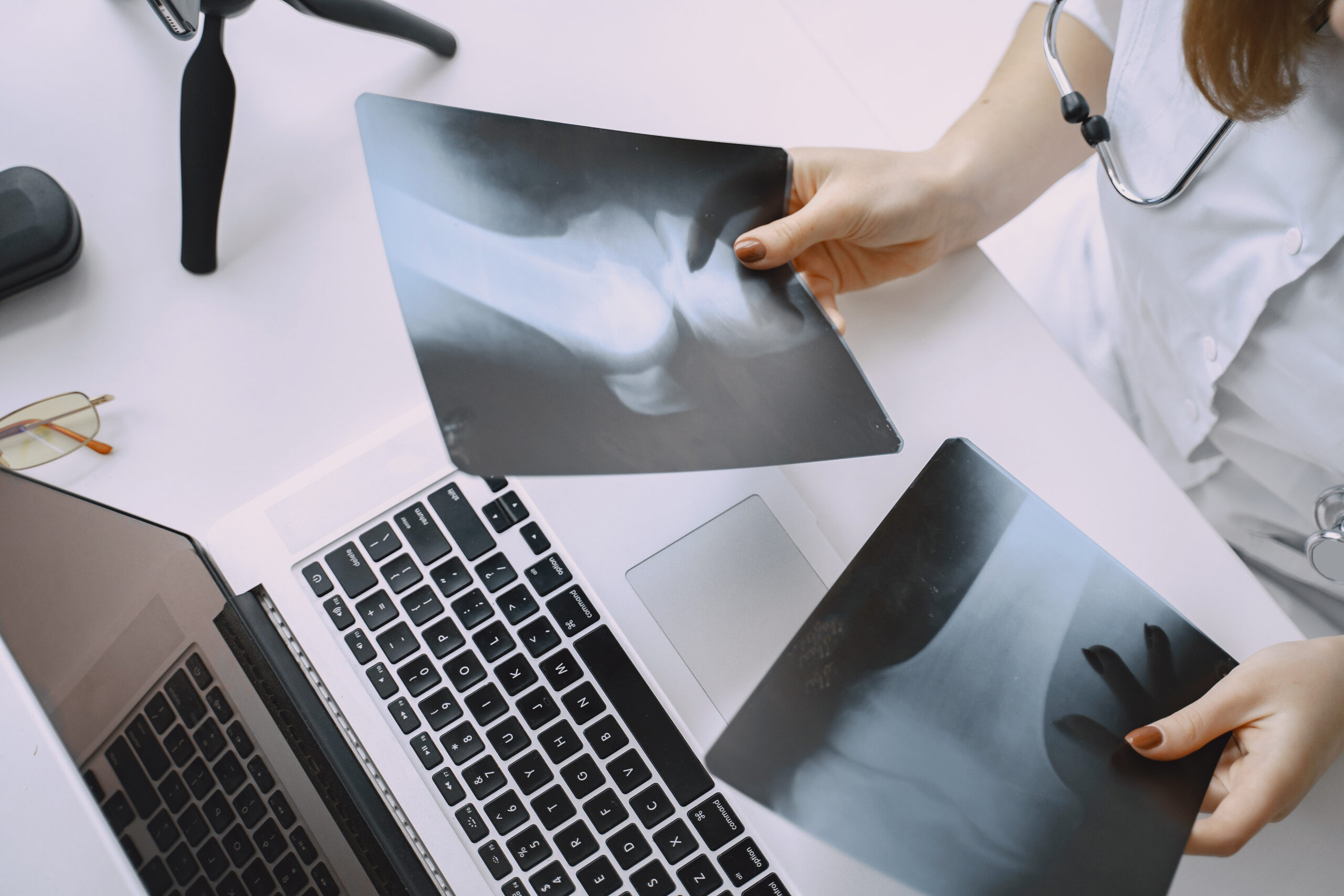Rheumatoid arthritis (RA) is a chronic and progressive condition. It begins with inflammation in the synovial membrane of the joints, which consequently leads to the destruction and deformation of the articular cartilage and the joints themselves, as well as their stiffening.
The disease is insidious and develops within a few weeks. In some cases, periods of remission alternate with exacerbations of symptoms. If left untreated, the deterioration of the functioning of the joint system continues to progress. Currently, with modern treatment, most patients achieve remission of the disease.

In most patients, rheumatoid arthritis![]() develops insidiously. It can take several weeks or even months before the manifestation becomes so intense that it requires medical help. Less often, patients encounter a sudden disease development (within a few days).
develops insidiously. It can take several weeks or even months before the manifestation becomes so intense that it requires medical help. Less often, patients encounter a sudden disease development (within a few days).
In the first place, individuals often experience general signs resembling common cold or flu, e.g., weakness, low-grade fever, muscle pain, loss of appetite, and weight loss. The symptoms can precede or accompany articular signs.
The condition generally involves the same areas on both sides of a person's body. An uncommon start of the disorder is inflammation of one large joint or the illness spreading to many joints. Symptoms of arthritis![]() include:
include:
Rheumatoid arthritis is a systemic condition that impacts the joints and organs. It occurs significantly in the long-term, severe conditions![]() :
:
If you experience joint pain and swelling, see a doctor immediately. Individuals who supposedly have rheumatoid arthritis should be under the maintenance of a specialist. Prompt diagnosis defines the usefulness of therapy, and if it is started early enough, there is even a possibility for permanent remission of the condition.
In rheumatoid arthritis, complications can appear that demand urgent medical intervention. Most often, specialists can prevent and treat them effectively.
Contact the doctor urgently if you experience:
The exact cause of rheumatoid arthritis![]() is unknown, although scientists point to the multifactorial nature of rheumatoid arthritis. Aspects that play a role in the development of the condition include:
is unknown, although scientists point to the multifactorial nature of rheumatoid arthritis. Aspects that play a role in the development of the condition include:
Risk factors![]() for rheumatoid arthritis include:
for rheumatoid arthritis include:
Diagnosing rheumatoid arthritis![]() is a process that involves several significant steps. It should include physical, imaging, laboratory, and genetic tests. It is the gold standard for detecting arthritis.
is a process that involves several significant steps. It should include physical, imaging, laboratory, and genetic tests. It is the gold standard for detecting arthritis.
Although imaging tests are more sensitive in diagnosing synovitis, it should be remembered that these are only ancillary tests. If rheumatoid arthritis is suspected, the number of painful and swollen joints should be assessed. It is associated with the destruction of joints. The number of swollen joints indicates a diagnosis of RA more than pain.

Laboratory diagnostics play a significant role in its detection, ensuring accurate and rapid detection and enabling monitoring of disease progression. Basic laboratory tests that are part of the diagnosis of rheumatoid arthritis include blood tests for the presence of specific antibodies: rheumatoid RF factor and antibodies against cyclic citrullinated peptide (anti-CCP).
Although specialists often use RF and anti-CCP testing, it is not specific only to this disease. Those tests may also detect antibodies in other autoimmune disorders. Hence, to improve diagnostic precision, specialists often use supplemental tests, such as measuring C-reactive protein (CRP) and erythrocyte sedimentation rate (ESR), which indicate overall body inflammation.
In the diagnostic process of early rheumatoid arthritis, other connective tissue diseases that may cause arthritis and require different therapeutic procedures should be excluded. When differentiating arthritis, attention should be paid to certain characteristic features of arthritis or extra-articular symptoms that may suggest a disease other than RA.
Currently, rheumatologists use the EULAR guidelines![]() to plan appropriate therapy for the patient. According to the recommendations, the most important thing is to start intensive therapy as soon as possible to achieve remission.
to plan appropriate therapy for the patient. According to the recommendations, the most important thing is to start intensive therapy as soon as possible to achieve remission.
This is due, among other things, to the fact that doctors and researchers believe that there is a so-called window of therapeutic possibilities in the initial stages of the disease, so quick treatment gives a chance to stop further progression and avoid the need for chronic drug use.
One of the significant principles within these guidelines is frequent assessment of treatment progress every 1–3 months, assuming that if there is no improvement or remission achieved after 3 to 6 months after starting therapy, the treatment should be changed.
Rheumatoid arthritis treatment includes:
Education![]() includes many programs organized by foundations throughout the country. It is significant that the patient understands the disease and knows how to try to control it.
includes many programs organized by foundations throughout the country. It is significant that the patient understands the disease and knows how to try to control it.
Drug treatment![]() includes several groups of drugs:
includes several groups of drugs:
Virtually all patients with rheumatoid arthritis require more than one drug to treat their disease, including at least one disease-modifying drug. Treatment must be carried out quickly and in appropriate doses to ensure maximum suppression of the disease and minimize the side effects of treatment.
Physiotherapy![]() is an integral element of the comprehensive rehabilitation of a patient suffering from RA. Thanks to it, the patient has a chance to function better, reduce the intake of painkillers, and improve the quality of life. The specialist should adapt it to the individualized patient's current condition.
is an integral element of the comprehensive rehabilitation of a patient suffering from RA. Thanks to it, the patient has a chance to function better, reduce the intake of painkillers, and improve the quality of life. The specialist should adapt it to the individualized patient's current condition.
During the remission period, treatment should be intensive and focused on physical exercises. This phase aims to:
Exercise, especially group exercise, also brings mental and social benefits. The following exercises are used to achieve the above effects: stretching, weight-bearing, resistance, dynamic, respiratory, and aerobic of moderate and high intensity, as well as specialized methods and tissue mobilizations.
During the exacerbation of the disease, passive, self-assisted, isometric, and breathing exercises are used. The therapeutic goal in this phase is to maintain the functional range of motion in the joints and relieve pain. The use of orthoses and auxiliary equipment is of great importance as it reduces the load on joints, reduces pain, inhibits the progression of hand deformities, and improves joint function during everyday activities.

The most effective physiotherapy treatments for rheumatoid arthritis include cryotherapy, laser therapy, ultrasound, TENS electrostimulation, magnetic field, and hydrotherapy. Classic massage is also effective.
To be beneficial, physiotherapy should be performed 5 times a week for 30 minutes. To make this possible, the patient should be aware of the nature of their disease and its treatment and educated on how to perform exercises on their own.
Surgical![]() (orthopedic) treatment should be considered when the pain can no longer be effectively controlled with maximum doses of medications and when there are significant joint deformations that significantly limit mobility. To select the appropriate procedure, the patient should contact an orthosurgeon through their treating physician orthopaedist.
(orthopedic) treatment should be considered when the pain can no longer be effectively controlled with maximum doses of medications and when there are significant joint deformations that significantly limit mobility. To select the appropriate procedure, the patient should contact an orthosurgeon through their treating physician orthopaedist.
In addition to conventional treatment methods, alternative ways to fight the disease exist. However, they cannot be used interchangeably with normal treatment. At most, they can be an addition to it. Worth mentioning are acupuncture![]() and acupressure, which may help control the pain associated with RA. Unfortunately, they do not influence the course of the disease and the development of joint changes.
and acupressure, which may help control the pain associated with RA. Unfortunately, they do not influence the course of the disease and the development of joint changes.
Currently, curing RA, i.e., the absence of the condition without the necessity to use medications, is very rare. Typically, the disorder recurs after discontinuation of DMARDs. Available treatment methods increasingly allow for disease remission and normal functioning. Unfortunately, in some patients, despite treatment, the disease worsens. Remission often occurs in pregnant women![]() , but the disease most often worsens within 3 months after giving birth.
, but the disease most often worsens within 3 months after giving birth.
RA is still associated with regular impairment. Individuals live several years shorter compared to the general population, mainly due to complications of atherosclerosis. Probably, thanks to earlier detection of rheumatoid arthritis and more and more effective treatment, these statistics will improve in the future.
Unfortunately, we do not know how to prevent![]() the development of RA. If you experience symptoms that suggest developing rheumatoid arthritis, do not delay and see a doctor as soon as possible. Only quick and accurate diagnosis and immediate treatment can prevent loss of fitness caused by the disease development.
the development of RA. If you experience symptoms that suggest developing rheumatoid arthritis, do not delay and see a doctor as soon as possible. Only quick and accurate diagnosis and immediate treatment can prevent loss of fitness caused by the disease development.
In a situation where the specialist has already made a diagnosis: